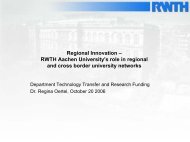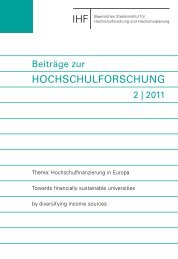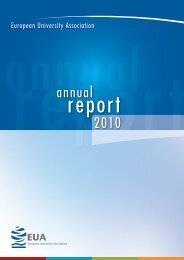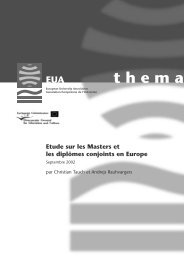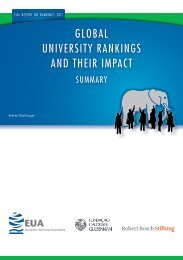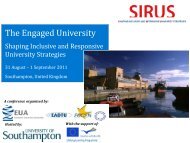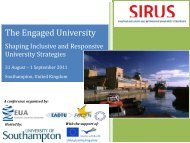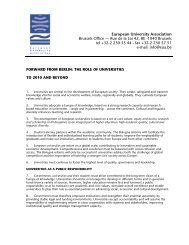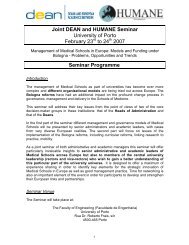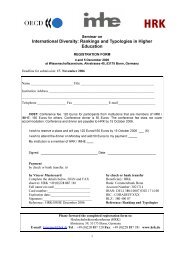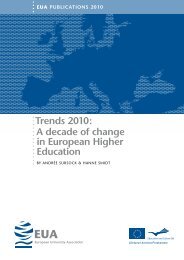Examining Quality Culture Part II: - European University Association
Examining Quality Culture Part II: - European University Association
Examining Quality Culture Part II: - European University Association
Create successful ePaper yourself
Turn your PDF publications into a flip-book with our unique Google optimized e-Paper software.
40<br />
ExAmININg QUALITy CULTUrE PArT <strong>II</strong>: PrOCESSES ANd TOOLS – PArTICIPATION, OwNErShIP ANd BUrEAUCrACy<br />
Second example<br />
In another example, the dean of a large faculty (6 500 students) explained the following feedback<br />
mechanisms. All students give feedback by using an online questionnaire that was developed centrally<br />
and focuses on specific study programmes. This feedback is complemented by a number of discussions<br />
with students in the faculty. The dean and vice deans collect students’ comments throughout the year by<br />
meeting quarterly with the head of student representatives to get feedback. In addition students are divided<br />
into groups by levels and programmes and they elect heads of groups who meet twice a year with the dean<br />
and vice deans. Every two years, students are asked for an overall evaluation of programmes.<br />
Third example<br />
Yet another faculty organises three feedback meetings a year to which all academics and staff are<br />
invited. The meetings focus on a specific theme but generally the student union extends the agenda by<br />
voicing any student concerns. In addition, teachers have an open door policy and consult students informally,<br />
and the students fill in an on-line questionnaire.<br />
Fourth example<br />
One university organises feedback in an unusual way: in addition to the standard questionnaire, an<br />
external teacher will meet with a group of students, at the end of a module or the beginning of a semester,<br />
to discuss what they liked and did not like and their recommendations. The actual teacher is not present<br />
during these conversations but will get a summary of the discussion.<br />
Fifth example<br />
One university collected oral feedback on its evaluation procedures through focus groups (cf.<br />
4.4). These are an effective instrument for evaluating services or testing new ideas. Focus groups usually<br />
gather six to ten people with a similar profile (e.g., students, academic staff, and administrative staff). The<br />
facilitator develops five to six questions for sessions that last from 60 to 90 minutes. To the extent that<br />
these sessions are essentially group interviews, many of the same guidelines for conducting interviews<br />
apply to them.<br />
6.3 Collecting feedback through institutional<br />
data and key performance indicators<br />
6.3.1 Institutional data<br />
The EQC survey results showed that nearly 99% of institutions had data information systems and<br />
that for 93% this was a centralised system. The collected data include generally: student progression and<br />
success rates (87.7%), the profile of the student population (83.2%), the teacher/student ratio (65.5%), the<br />
results of the student questionnaires (53.6%), the cost of learning resources (44.1%) and tracking graduates’<br />
employment (40.5%) (Loukkola and Zhang 2010: 26).



